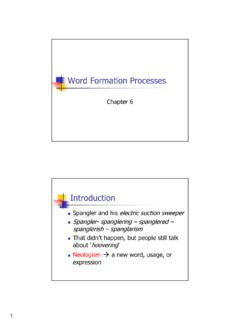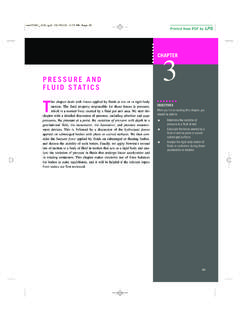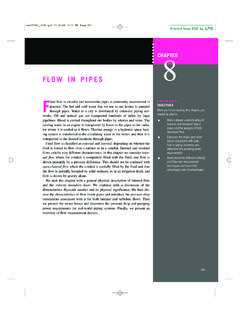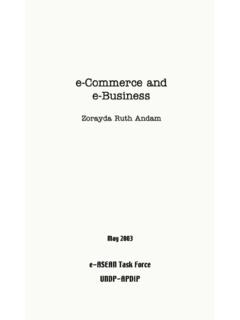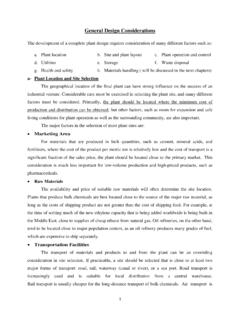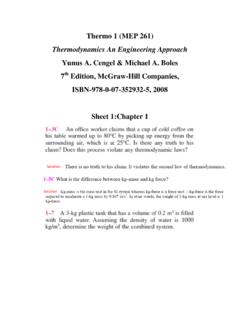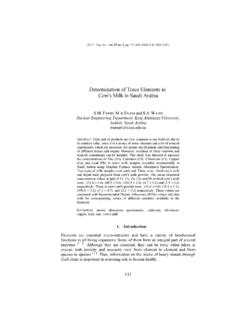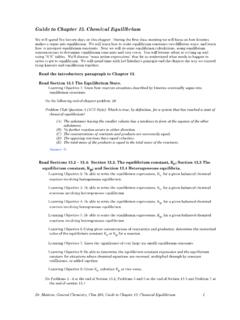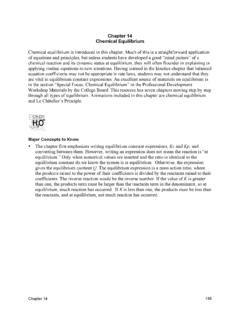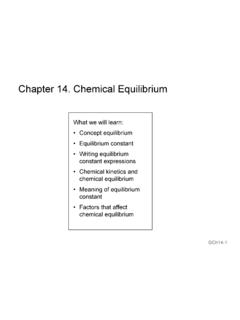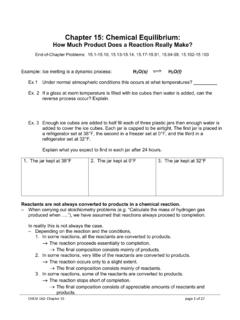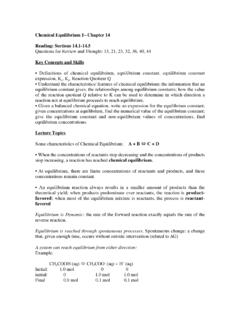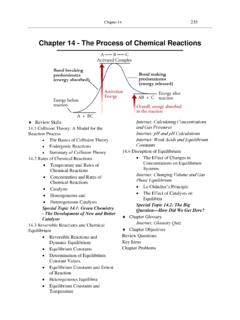Transcription of Chemical Equilibrium - kau
1 Chemical EquilibriumChapter 14 Copyright The McGraw-Hill Companies, Inc. Permission required for reproduction or a state in which there are no observable changes as time goes equilibriumis achieved when: the rates of the forward and reverse reactions are equal and the concentrations of the reactants and products remain constantPhysical equilibriumH2O (l) Chemical equilibriumN2O4(g) (g)2NO2(g)N2O4(g)2NO2(g)Start with NO2 Start with N2O4 Start with NO2& (g)2NO2(g)= x 10-3K= [NO2]2[N2O4]aA+ bBcC+ dDK= [C]c[D]d[A]a[B]bLaw of Mass >> 1K<< 1 Lie to the rightFavor productsLie to the leftFavor reactantsEquilibrium WillK= [C]c[D]d[A]a[B]baA+ bBcC+ Equilibrium applies to reactions in which all reacting species are in the same (g)2NO2(g)Kc= [NO2]2[N2O4]Kp= NO2P2N2O4 PaA(g)+ bB(g)cC(g)+ dD(g) Kc(RT) n n = moles of gaseous products moles of gaseous reactants= (c+ d) (a+ b)In most casesKc KpHomogeneous EquilibriumCH3 COOH (aq)+ H2O (l)CH3 COO-(aq)+ H3O+ (aq)
2 Kc= [CH3 COO-][H3O+][CH3 COOH][H2O][H2O] = constantKc= [CH3 COO-][H3O+][CH3 COOH]= Kc[H2O] General practice notto include units for the Equilibrium Equilibrium concentrations for the reaction between carbon monoxide and molecular chlorine to form COCl2(g) at 740C are [CO] = M, [Cl2] = M, and [COCl2] = M. Calculate the Equilibrium constants Kcand (g)+ Cl2(g)COCl2(g)Kc= [COCl2][CO][Cl2]= x 220Kp= Kc(RT) n n= 1 2 = -1R= 273 + 74 = 347 KKp= 220 x ( x 347)-1= Equilibrium constant Kpfor the reactionis 158 at 1000K. What is the Equilibrium pressure of O2if the PNO = atm and PNO= atm?22NO2(g) 2NO (g) + O2(g) 2 PNO PO2 PNO22PO2= KpPNO22 PNO2PO2= 158 x ( )2/( )2= 347 atmHeterogenous Equilibrium applies to reactions in which reactants and products are in different (s)CaO(s)+ CO2(g)Kc= [CaO][CO2][CaCO3][CaCO3] = constant[CaO] = constantKc= [CO2] = Kcx [CaCO3][CaO]Kp= PCO2 The concentration of solidsand pure liquidsare not included in the expression for the Equilibrium KpCaCO3(s)CaO(s)+ CO2(g)PCO2does not depend on the amount of CaCO3or the following Equilibrium at 295 K:The partial pressure of each gas is atm.
3 Calculate Kpand Kcfor the reaction?NH4HS (s)NH3(g)+ H2S (g)Kp= PNH3H2SP= x = Kc(RT) nKc= Kp(RT)- n n= 2 0 = 2T= 295 KKc= x ( x 295)-2= x + B C + DC + D E + FA + B E + FKc= [C][D][A][B]Kc= [E][F][C][D][E][F][A][B]Kc= Kc Kc KcKc= Kc Kc xIf a reaction can be expressed as the sum of two or more reactions, the Equilibrium constant for the overall reaction is given by the product of the Equilibrium constants of the individual (g)2NO2(g)= x 10-3K= [NO2]2[N2O4]2NO2(g)N2O4(g)K= [N2O4][NO2]2 =1K= 216 When the equation for a reversible reaction is written in the opposite direction, the Equilibrium constant becomes the reciprocal of the original Equilibrium Equilibrium Constant Expressions1. The concentrations of the reacting species in the condensed phase are expressed in M.
4 In the gaseous phase, the concentrations can be expressed in Mor in The concentrations of pure solids, pure liquids and solvents do not appear in the Equilibrium constant The Equilibrium constant is a dimensionless In quoting a value for the Equilibrium constant, you must specify the balanced equation and the If a reaction can be expressed as a sum of two or more reactions, the Equilibrium constant for the overall reaction is given by the product of the Equilibrium constants of the individual Kinetics and Chemical EquilibriumA + 2B AB2kfkrratef= kf[A][B]2rater= kr[AB2]Equilibriumratef= raterkf[A][B]2= kr[AB2]kfkr[AB2][A][B]2=Kc=The reaction quotient (Qc)is calculated by substituting the initial concentrations of the reactants and products into the Equilibrium constant (Kc) Qc> Kcsystem proceeds from right to left to reach Equilibrium Qc= Kcthe system is at Equilibrium Qc< Kcsystem proceeds from left to right to reach Equilibrium Equilibrium Concentrations1.
5 Express the Equilibrium concentrations of all species in terms of the initial concentrations and a single unknown x, which represents the change in Write the Equilibrium constant expression in terms of the Equilibrium concentrations. Knowing the value of the Equilibrium constant, solve for Having solved for x, calculate the Equilibrium concentrations of all 12800C the Equilibrium constant (Kc) for the reactionIs x 10-3. If the initial concentrations are [Br2] = Mand [Br] = M, calculate the concentrations of these species at (g) 2Br (g)Br2(g) 2Br (g)Let xbe the change in concentration of Br2 Initial (M)Change (M) Equilibrium (M) + + 2x[Br]2[Br2]Kc= Kc= ( + 2x) -x= x 10-3 Solve for ( + 2x) -x= x 10-34x2+ + = + + = 0ax2+ bx+ c=0-b b2 4ac 2ax= Br2(g) 2Br (g)Initial (M)Change (M) Equilibrium (M) + + 2xx= Equilibrium , [Br] = + 2x= Mor MAt Equilibrium , [Br2] = x= an external stress is applied to a system at Equilibrium , thesystem adjusts in such a way that the stress is partially offsetas the system reaches a new Equilibrium position.
6 Le Ch telier s Principle Changes in ConcentrationN2(g)+ 3H2(g)2NH3(g)AddNH3 Equilibrium shifts left to offset Ch telier s Principle Changes in Concentration continuedChangeShifts the EquilibriumIncrease concentration of product(s)leftDecrease concentration of product(s)rightDecrease concentration of reactant(s)Increase concentration of reactant(s) + bBcC+ dDAddAddRemoveRemoveLe Ch telier s Principle Changes in Volume and PressureA (g)+ B (g) C (g)ChangeShifts the EquilibriumIncrease pressure Side with fewest moles of gasDecrease pressureSide with most moles of gasDecrease volumeIncrease volumeSide with most moles of gasSide with fewest moles of Ch telier s Principle Changes in TemperatureChangeExothermic RxIncrease temperature KdecreasesDecrease temperatureKincreasesEndothermic lowers Eafor bothforward and reverse does not change Equilibrium constant or shift Equilibrium .
7 Adding a Catalyst does not change K does not shift the position of an Equilibrium system system will reach Equilibrium soonerLe Ch telier s PrincipleChemistry In ActionLife at High Altitudes and Hemoglobin ProductionKc= [HbO2][Hb][O2]Hb (aq) + O2(aq) HbO2(aq)Chemistry In Action: The Haber ProcessN2(g) + 3H2(g) 2NH3(g) H0= kJ/molLe Ch telier s PrincipleChangeShift EquilibriumChange
